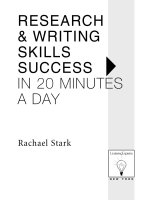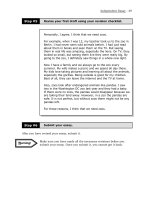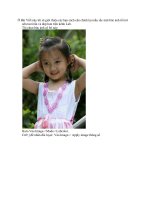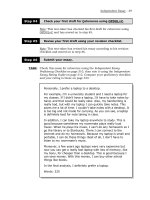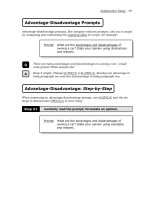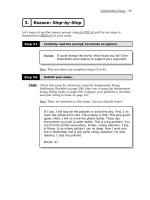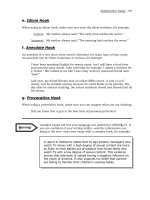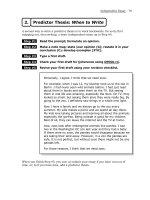Tài liệu RESEARCH AND WRITING SKILLS SUCCESS PART 3 docx
Bạn đang xem bản rút gọn của tài liệu. Xem và tải ngay bản đầy đủ của tài liệu tại đây (67.57 KB, 7 trang )
B
efore you begin the steps it takes to write a research paper, it is a good idea to find out
how much you know about the research process. This pretest is designed to ask you some
basic questions—ones that cover all the lessons in Research & Writing Skills. The objective of the
pretest is to measure what you already know and what you need to know. The questions in this
pretest do not cover all the topics discussed in each chapter, so even if you can answer every sin-
gle question in this pretest correctly, there are still many practical writing strategies and style
issues to learn. On the other hand, if there are many questions on the pretest that puzzle you, or
if you find that you do not get a good percentage of answers correct, don’t worry. This book is
designed to take you through the entire research/writing process in effective step-by-step lessons.
This pretest should be a diagnostic tool for you. If your score is high, you might be able to
spend a little less time with this book than you originally planned. If your score is lower than you
would like it to be, you may want to devote a little more than twenty minutes to practice each day
in order to acquire some necessary research skills. Either way, the amount of time you devote to
this book and these lessons will be time well spent. You will learn valuable techniques to help you
write a good research paper on any topic.
Pretest
1
On the next page, you will find an answer
sheet for the pretest. If you do not own this
book, you can write the numbers 1-50 on a
piece of blank paper and mark your answers
there. Before you begin, relax, find a quiet
place to work, and take as much time as you
need for this short test. Once you have fin-
ished, you can check your answers with the
answer key at the end of this the test. Every
answer includes a reference to a corresponding
lesson. If you answer a question incorrectly,
turn to the chapter that covers that particular
topic, and you will be able to understand the
question better. Good luck and remember to
use this test as a jumping off point—a place to
begin the work of writing a superior research
paper.
–
PRETEST
–
2
–
ANSWER SHEET
–
3
Pretest
1. abcd
2. abcd
3. abcd
4. abcd
5. abcd
6. abcd
7. abcd
8. abcd
9. abcd
10. abcd
11. abcd
12. abcd
13. abcd
14. abcd
15. abcd
16. abcd
17. abcd
18. abcd
19. abcd
20. abcd
21. abcd
22. abcd
23. abcd
24. abcd
25. abcd
26. abcd
27. abcd
28. abcd
29. abcd
30. abcd
31. abcd
32. abcd
33. abcd
34. abcd
35. abcd
36. abcd
37. abcd
38. abcd
39. abcd
40. abcd
41. abcd
42. abcd
43. abcd
44. abcd
45. abcd
46. abcd
47. abcd
48. abcd
49. abcd
50. abcd
Choose the best answer for each of the follow-
ing questions.
1.
A research paper is different from an
essay because
a. an essay contains fewer facts than a
research paper.
b. an essay is more opinion dominated.
c. a research paper is an extended
analysis based on data and evidence.
d. a research paper is always shorter than
an essay.
2.
Establishing a strong, authoritative tone
in your research paper means
a. using a lot of factual information.
b. choosing a writing style that
establishes the writer as an authority.
c. using harsh vocabulary words.
d. writing a persuasive paper.
3.
In a research paper, footnotes usually
appear
a. in the table of contents.
b. in the introductory paragraph.
c. at the bottom of the page.
d. within the thesis statement.
4.
An introductory paragraph should
always contain
a. the thesis statement.
b. as many facts as possible.
c. a summary of the subject matter.
d. a table of contents.
5.
To proofread any document—including
your research paper—means to
thoroughly
a. rewrite any sections that need work.
b. restate the thesis argument.
c. check for any spelling or grammatical
errors and correct them.
d. change the pagination and footnotes.
6.
A bibliography is an essential component
of any research paper because it
a. demonstrates to the reader the full
knowledge of the writer.
b. officially lists all the sources the writer
has consulted.
c. makes a final statement at the end of
the paper.
d. helps the reader understand the
content of the paper.
7.
A primary source
a. is the first source the writer has
consulted.
b. always includes electronic material
taken directly from the web.
c. is a better source of information than
any other.
d. includes eyewitness accounts or first-
hand information about the event or
topic discussed in the paper.
–
PRETEST
–
5
